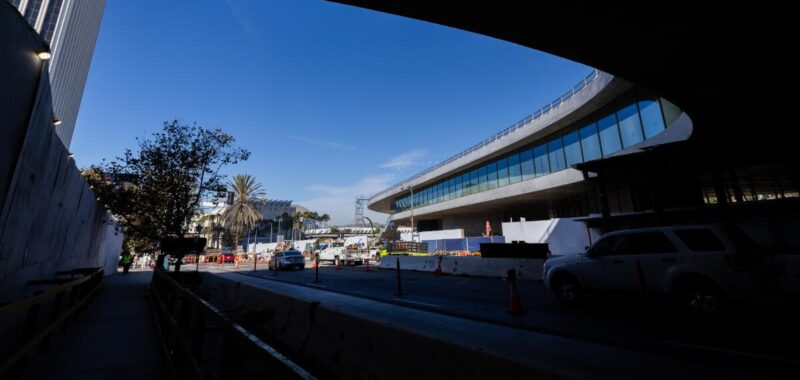
The Los Angeles County Museum of Art’s new David Geffen Galleries will open to the public in April 2026, the museum announced Friday as scaffolding is coming down around the Peter Zumthor-designed building, revealing the most expansive view yet of the 900-foot-long, poured concrete structure spanning Wilshire Boulevard.
During The Times’ tour of the site this week, LACMA said 90% of the construction has been completed and the project is moving into its final phase. In early 2025, the museum said, it will begin moving key staff and operations into the building. At some point, likely in the spring, museum members and others will get a chance to tour the empty building, LACMA said. Pieces of the museum’s collection will then begin arriving in the 110,000 square feet of gallery space.
Drivers and pedestrians approaching the museum from the east will pass under the full expanse of the building’s 150-foot, free span bridge, which frames Chris Burden’s famous “Urban Light” sculpture as the boulevard curves slightly north and continues down toward the LACMA campus at a slight downhill grade. The portion of the building that perches on the south side of Wilshire, where a surface parking lot once stood, will include a cafe that will look out on the street, as well as a 300-seat theater housed in one of seven, 30-foot-tall ground-level pavilions holding the museum’s exhibition floor aloft. Other pavilion bases will hold a restaurant, the LACMA store and the W.M. Keck Education Center, the museum said.
Those viewing the building from the street can catch a peek of LACMA’s 1988 Japanese Pavilion under the new building’s curvilinear body. Visitors approaching from the La Brea Tar Pits can see portions of “Urban Light” and eventually will have a more direct connection to walk between the tar pits and the LACMA campus. Passersby can get a better sense of the new building’s 243 floor-to-ceiling windows, which the museum touts as providing 360-degree views of the city but which have been the source of angst among architecture enthusiasts, as the curved glass in earlier plans has been replaced with linear glass at odds with the arcs of the concrete.
Early renderings of the building showed the windows with curtains, and much speculation has ensued about how these curtains will look — and to what extent they will be transparent. In 2022 the National Endowment for the Humanities awarded LACMA $500,000 for “custom gallery elements,” including “light-blocking curtains” and “custom case work.”
LACMA’s latest announcement does not address the curtains question but does note that art will be displayed in light-filled terraces as well as in sheltered interior galleries suitable for light-sensitive works. “Thousands of works of art in our collection can be safely displayed in natural light,” the museum has said on its website. “In fact, sculpture, tiles, ceramics, and more were meant to be viewed in natural light, and many were made for outdoor display.”
LACMA has likened Zumthor‘s design to a kind of living organism. Indeed, the raw concrete is already showing signs of weathering, with water stains and other irregularities. The exterior walls are punctured at various points with circular holes that allow the air to come in and out of the building. The outline of the triangular ribs of the building’s core can be seen from the ground looking up.
LACMA Chief Executive Michael Govan has long said that the Zumthor building will not have a traditional main entrance. Tickets will be available for purchase on both sides of Wilshire. Two cantilevered staircases rise from street level to these entrances, and the building reflects itself with its curves.
“LACMA is part of a larger whole, which includes our neighbors the La Brea Tar Pits and Museum, the Academy Museum, the Petersen Automotive Museum, and Craft Contemporary,” Govan said. “That is 30 acres with approximately 500,000 square feet of exhibition space, restaurants, theaters and outdoor events. We’re excited to be a great resource for L.A.”
Construction on the Zumthor building began in 2020, but it has been in the works for more than a decade. Times art critic Christopher Knight has called it the “incredible shrinking museum,” noting that the new building has less exhibition space than the four buildings that were torn down to make room for it. LACMA contends that with the 2008 addition of the Broad Contemporary Art Museum building and the 2010 addition of Lynda and Stewart Resnick Exhibition Pavilion, the new LACMA will have more gallery space than it did in 2007.
The Times reported that the original project cost was $650 million, which rose after a yearlong delay precipitated by the discovery of fossils and tar under the construction site.
A LACMA representative cited a partial project cost of $715 million that included “hard costs, soft costs, and contingency (includes building furniture, curtain/curtain track, landscape, sitework, etc.).” The cost of art exhibition installation and vitrines were not included in that total, and the museum said it does not yet know what the total project cost will be.
“Of course we will be happy in the end to report that we are investing even more in LACMA beyond the building, including public art,” Govan said.
A source previously told The Times that the total project cost is hovering around $835 million. LACMA contested that estimate. “As of today we don’t have a total,” Govan said in an interview. “There is no $835 million budget that I’ve seen or know about.”
Fundraising, the museum said, has exceeded goals and stands at $793 million.
“Other than an unprecedented large paleontological find and tar, which delayed us by a year, if you take everything into account including inflation over time and apples-to-apples comparisons of what is included, as far as I’m concerned we are on our plan for cost and time from our projections of over a decade ago,” Govan said.

